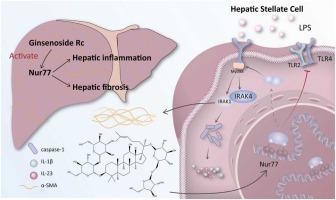Acta Histochemica ( IF 2.5 ) Pub Date : 2023-07-30 , DOI: 10.1016/j.acthis.2023.152079 Bo-Feng Qin 1 , Shan Gao 1 , Qi-Yuan Feng 1 , Wei Chen 1 , Hai-Ming Sun 1 , Jian Song 1

|
HSCs (hepatic stellate cells) contribute to the excessive extracellular matrix (ECM) deposition plays a key role in the progression of hepatic fibrosis. The present study focused on the hepatoprotective effect of Ginsenoside Rc (Rc), one of the protopanaxadiol type ginsenoside, which has contributed to reverse activated HSCs to improve hepatic fibrosis via regulating Nur77-TLR4/MyD88 signaling pathway. We established the hepatic fibrosis model by intraperitoneal injection of carbon tetrachloride (CCl4). And HSCs were stimulated with TGF-β, followed by silencing of Nur77, and then incubated in Rc. Rc significantly alleviated histopathological changes, reduced serum alanine aminotransferase (ALT) and aspartate aminotransferase (AST) levels. Rc could upregulate the Nur77 and downregulate fibrosis markers in the liver of mice, including decreasing the expressions of α-SMA, Collagen-I, the ratio of TIMP-1/MMP-13. Rc significantly increased the expression of Nur77 and suppressed the production of ECM in HSCs. Rc inhibited TLR4 signaling pathway, consequently reversing the inflammatory response, including the production of MyD88, IRAK1, IRAK4 and IL-23. When Nur77 was knocked in TGF-β-stimulated HSCs, TLR4 and α-SMA production were increased. Rc suppressed these activatory effects in Nur77 knockdown HSCs. Rc reduced inflammatory reaction by regulating the Nur77-TLR4 signaling pathway while suppressing the fibrogenesis suggesting, underscoring a promising approach of Rc for the treatment in hepatic fibrosis. Targeting Nur77-TLR4 signaling in HSCs would be the potential strategy for Rc against hepatic fibrosis.
中文翻译:

人参皂苷 Rc 需要调节 Nur77-TLR4/MyD88 信号通路,通过灭活肝星状细胞来改善肝纤维化消退
HSC(肝星状细胞)导致细胞外基质(ECM)过度沉积,在肝纤维化的进展中发挥关键作用。本研究重点关注人参皂苷Rc(Rc)的保肝作用,Rc是原人参二醇型人参皂苷之一,通过调节Nur77-TLR4/MyD88信号通路,有助于逆转活化的HSC,改善肝纤维化。我们通过腹腔注射四氯化碳(CCl 4 )建立肝纤维化模型。用TGF-β刺激HSC,然后沉默Nur77,然后在Rc中孵育。Rc显着减轻组织病理学变化,降低血清丙氨酸氨基转移酶(ALT)和天冬氨酸氨基转移酶(AST)水平。Rc可以上调Nur77并下调小鼠肝脏中的纤维化标志物,包括降低α-SMA、Collagen-I的表达、TIMP-1/MMP-13的比值。Rc 显着增加 Nur77 的表达并抑制 HSC 中 ECM 的产生。Rc 抑制TLR4信号通路,从而逆转炎症反应,包括 MyD88、 IRAK1、 IRAK4 和 IL-23 的产生。当 TGF-β 刺激的 HSC 中 Nur77 被敲除时,TLR4 和 α-SMA 的产生增加。Rc 抑制 Nur77 敲低 HSC 中的这些激活作用。Rc 通过调节 Nur77-TLR4 信号通路减少炎症反应,同时抑制纤维形成,这表明 Rc 是治疗肝纤维化的一种有前景的方法。靶向 HSC 中的 Nur77-TLR4 信号传导将是 Rc 抗肝纤维化的潜在策略。



























 京公网安备 11010802027423号
京公网安备 11010802027423号